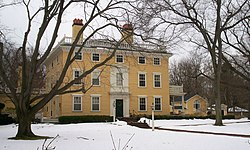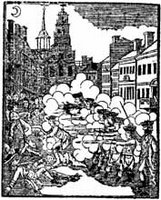Most people who follow early American history know that after the
Boston Massacre the
British soldiers were put on trial for murder. People who study the topic more closely know that there were separate trials for Capt.
Thomas Preston and the eight enlisted men.
At those trials
John Adams and
Josiah Quincy, Jr., handled the defense alongside future
Loyalists Robert Auchmuty and
Sampson Salter Blowers. They won acquittals for most of the accused, convictions for manslaughter instead of murder for two. Americans remember the Whig lawyers’ work for the soldiers as a touchstone of every defendant’s right to a vigorous legal defense.
But there was a
third murder trial after the Massacre which we hear very little about. While the record of the soldiers’ trial was reprinted multiple times in the 1800s, the publishers left out the description of that third trial which was originally printed with it.
That trial grew out of the claims of
Charles Bourgate, a teenager of
French extraction who worked for
Customs official
Edward Manwaring. For reasons of his own, Charles accused his master of having fired a gun out of an upper floor of the Customs house at the crowd on King Street.
When the teenager first made this accusation, Manwaring quickly refuted it by bringing in a friend, notary
John Munro, to testify that the two of them had been somewhere else at the time. In addition,
Hammond Green and
Thomas Greenwood testified that they had been in that room of the Customs House during the violence, not seeing Manwaring or anyone else shoot out the windows.
Bourgate then revised his testimony to say that
both Manwaring and Munro had been up in the room with guns. And that Hammond Green had yanked him into the Customs House to shoot a gun as well. This made no sense, but it allowed the Boston Whigs to arrest all four of those men and discount their testimony—after all, one should expect accused murderers to lie to protect themselves. Soon the town was proclaiming that it had evidence for a Customs service conspiracy against the people.
It looks like the judicial system recognized the relative weaknesses of this case. While Capt. Preston and the soldiers remained in jail until their trial, Green was released on bond on 7 April, as
this document from the Boston Public Library collection shows. It identified Green as a “Boat builder.” His sureties were fellow boatbuilder Thomas Hitchbourn and the printers
Richard Draper of the
Boston News-Letter and
John Green and Joseph Russell of the
Boston Post-Boy.
The Customs men’s trial finally started on 12 December, after the soldiers’ ended.
Samuel Quincy (shown above) had the difficult task of prosecuting. Bourgate repeated the latest version of his story under oath. Another youth (“Some people thought him foolish”) described seeing flashes from the Customs House windows. Then the defense called its witnesses.
Four merchants stated they had seen no shots from the windows. One of those men,
Edward Payne, had been wounded in the Massacre, so he had no reason to cover up anything.
Elizabeth Avery testified that she had watched the shooting with Hammond Green:
There was no other people in this room, (except them I have mentioned) during the whole time of my being there, but Thomas Greenwood who came in and went out again in a minute. Nor was there any gun or pistol, or candle in the room. Nor was the door of the balcony or any of the windows of the chamber opened that evening to my knowledge, and I verily believe they were not. The French Boy, who has just been sworn in this Court was not there that evening, nor did I ever see him there in my life. Nor was Mr. Manwarring or Mr Munroe there on that evening.
Hammond’s sister
Ann stated the same.
Later the defense attorneys called a man who had spent time in the Boston jail with Charles Bourgate and said the boy had boasted of the reward he would get for perjuring himself. Charles denied that, but the jury cleared the Customs men of murder without getting up from their seats. The acquittal even
made the London Chronicle.
I can’t tell if Hammond Green worked for the Customs service in 1770 or simply lived with his father who did. But by the time the war broke out, he was on the payroll as a tidesman. In March 1776 Hammond Green
evacuated to Halifax with the British army, leaving behind his wife, Mary, and their child. In July 1777 the
Massachusetts legislature granted permission for them to join him in Nova Scotia. Mary died in the following years, and in 1785 Hammond married Elizabeth Mott, young daughter of a former Royal Artillery
mattross. Green was still working as a tidesman at Halifax in 1807, thirty-seven years after being tried and acquitted for the Boston Massacre.




++Queen+Charlotte,+Princess+Sophia+Charlotte+of+Mecklenburg-Strelitz,+1744+-+1818.+Queen+of+George+III+About+1763.jpg)










